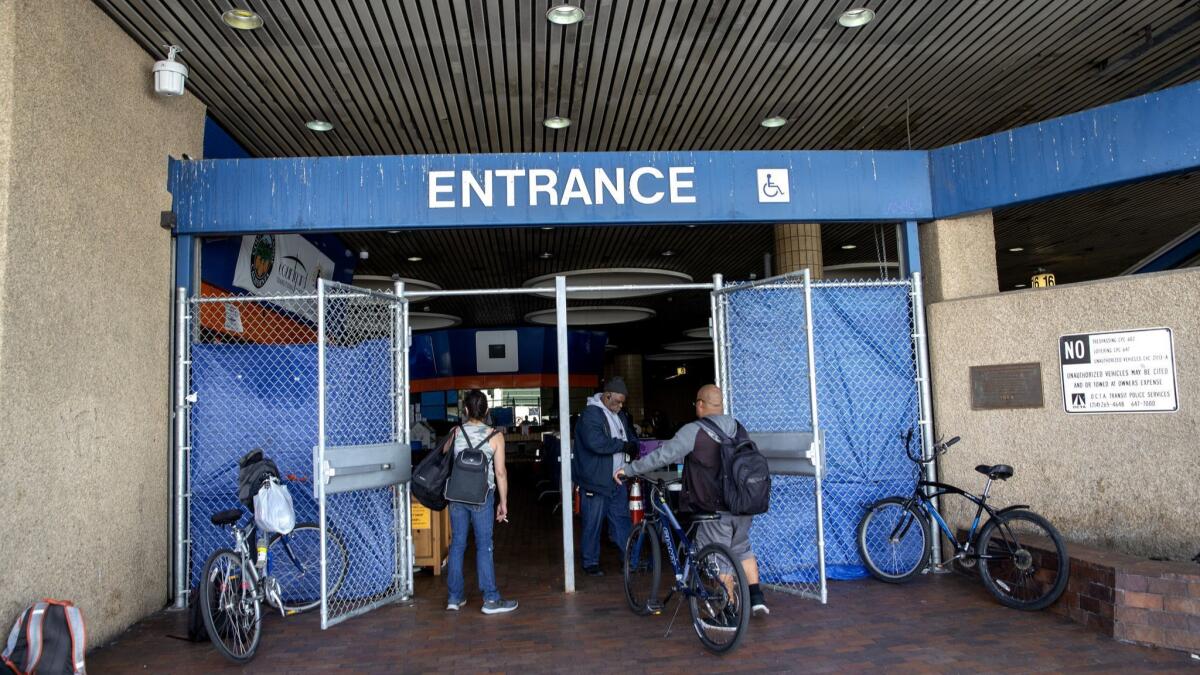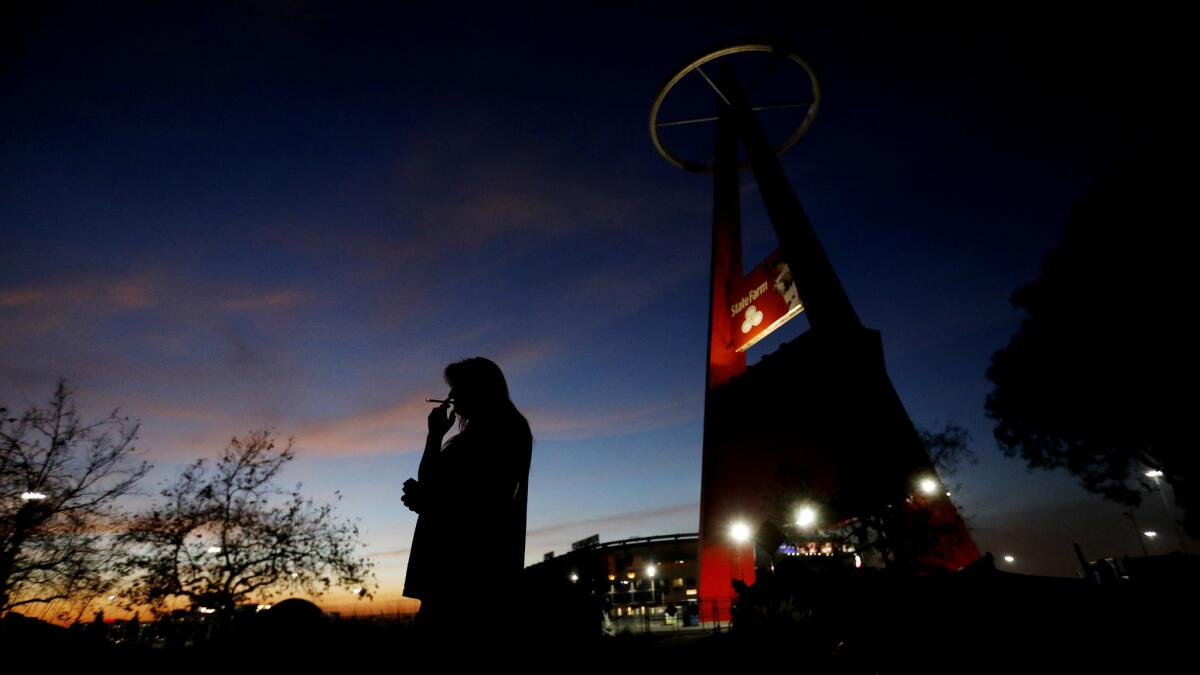ACLU report gives damning review of Orange County homeless shelters: ‘Jail is better’

A yearlong investigation found three of Orange County’s emergency homeless shelters riddled with problems including reports of physical and sexual abuse, neglect of residents with disabilities and mental illnesses, and filthy conditions, according to a report released Thursday by the American Civil Liberties Union.
The report is based on first-person visits and more than 70 interviews with residents, staff members and shelter volunteers at three emergency shelters: the Courtyard Transitional Center in Santa Ana, opened in October 2016; Bridges at Kraemer Place in Anaheim that opened in May 2017; and SAFEPlace in Santa Ana, which opened last April.
They say they found dangerously unclean conditions in each of the shelters; facilities that lacked temperature control and in some cases, flooded during rainstorms; and reports of staff threatening residents with eviction for minor infractions, or if they spoke out about conditions at the shelter.
DOCUMENT: Read the ACLU’s scathing report on Orange County’s homeless shelters »
“People who have been to jail have said jail is better than this shelter,” one homeless resident, Roberta Filicko, wrote in her diary, according to the ACLU report. “We are so scared that we will be living on the streets, and the staff make sure to remind you of this every minute of every day. It’s true we have no one to help us, so we go along with it.”
An employee at one of the Santa Ana emergency homeless shelters found that bedbugs would crawl on you if you sat down long enough.
“I got three bites (during my last shift),” the employee told an interviewer. “Some [people] are getting a lot more. You can see the bedbugs when they get on you. They are big. They’ve been around for a while.”
At another Orange County emergency shelter in Anaheim, residents and staff faced similar problems.
“Critters all around,” a resident told an interviewer. “Mosquitos, cockroaches. I saw a couple of people with head lice. Staff would say, ‘Hide the bugs, don’t let [the supervisor] see that.’ ”
She added: “It is one of the filthiest shelters I have been in.”
Document
“Many residents told us that unsanitary conditions in the showers and restrooms are a particular source of concern.
‘The showers got bad,’ recalls a former resident. ‘Dirty, trash. It builds up. I saw personal body fluids on the sinks. Either blood or snot. It was so bad that I wouldn’t want to go in them.’
A resident observes, ‘Feces on the walls and the showers. They don’t clean it properly.’
Says another resident, ‘I went nine days without taking a shower, because I don’t want to get sick.’”
see the documentOrange County spokeswoman Molly Nichelson said in a statement that the county will take time to review the report and respond accordingly. She declined a request from The Times for an interview.
“The County of Orange is committed to ensuring our emergency shelters are safe for all our clients,” Nichelson said. “Each emergency shelter has its own provider and complaint process. We work to ensure valid complaints are addressed by our service providers in a timely fashion.”
In an email to The Times, the state attorney general’s office said it was “reviewing the contents of the report.”
The ACLU, which launched a Dignity for All project in 2013 to address homelessness in Orange County, said staffers cross-verified their interviews with multiple sources, including public records and data, according to the report.
The ACLU argues that the shelters are ineffective in ending homelessness; in its report, the civil rights organization advocates for an expansion of affordable housing and permanent supportive housing.
“There’s a special sort of cruel irony that this is such a wealthy county, and the homeless community is relatively small compared to a county like Los Angeles,” said Julia Devanthery, a staff attorney at the ACLU of Southern California and one of the authors of the report. “And yet, there is no meaningful movement toward expanding access to affordable housing and supportive housing, which everyone who works on this issue agrees is a solution.”
More temporary shelters are set to open in the coming months across Orange County, prompting the ACLU to release its report, Devanthery said.
In 2017, almost 4,800 people in Orange County were found in the annual Point in Time count to be experiencing homelessness. Orange County officials felt it was an undercount.

Hundreds of homeless residents lived along the banks of the Santa Ana River until they were removed and sent to live in motels and shelters across the county. Many have been removed from a large encampment at the Santa Ana Civic Center.
Over the last few years, Orange County officials have grappled with how to implement solutions to help homeless residents — often to large protests about proposed shelters from residents in the county’s wealthier communities.
A series of lawsuits have attempted to force solutions, including a lawsuit filed in February against five Orange County cities — Aliso Viejo, Dana Point, Irvine, San Clemente and San Juan Capistrano — and the county for failure to provide housing for homeless people.
The ACLU’s Devanthery said the organization has examined what legal remedies exist to address the conditions they found at the temporary shelters.
Document
“On July 7, 2018, for example, a record-breaking heat wave baked the sidewalks around the Courtyard as the outdoor temperature rose to 107 degrees. Inside, a volunteer measured the temperature with a thermometer purchased especially to record the temperature that day. It registered 96 degrees, as scores of residents sat listlessly on their cots or dragged themselves into line for bottled water.”
see the documentBrooke Weitzman, an attorney who has represented homeless residents in multiple lawsuits against the county, said conditions vary widely among shelters in Orange County, as each shelter is run by different organizations with their own staff training protocols and rules for residents.
In recent years, local officials have discussed homelessness in Orange County much more frequently, but haven’t made significant progress in approving and building housing, said Weitzman, an attorney and co-founder of the Elder Law and Disability Rights Center.
“I think we’re at a point where most of them recognize it is necessary and needs to be done,” said Weitzman, who wasn’t involved in the ACLU investigation. “But knowing that doesn’t necessarily mean they’re willing to do it in the face of residents opposing any type of development or affordable housing or permanent supportive housing.”
The report provides a scathing review of the shelters, which officials have lauded as progress in combating homelessness in Orange County, and includes graphic details from witnesses.
Document
“A woman with an inoperable brain aneurism gets headaches when the aneurism bleeds. ‘Two or three times when I had the pain,’ she says, ‘I wanted to go to the hospital. The last time it was 7:00 or 8:00 in the evening. The staff wouldn’t give me ice packs, wouldn’t call 911, and wouldn’t give me a ride [to the hospital] because they said the shuttle drivers were off until 11:00 p.m. I sat there and suffered. I was terrified. I wasn’t allowed to walk out the gate. They will exit you.’”
see the documentAt SAFEPlace, a gymnasium housing about 70 people, a resident at the shelter recalled an 82-year-old resident who had dementia and was frequently tricked by scam artists calling her cellphone. To “teach her a lesson” after she was scammed yet again, a staff member forced her to spend at least a day outside the shelter’s fence, according to the report.
“She didn’t understand what was going on, and it was getting dark and cold,” a resident told the ACLU. “We were begging the security guard to open the gate and let her back in, but they said they had to follow orders.”
At the Courtyard, a former bus terminal that houses more than 450 people, an employee told the ACLU about when staff refused to take in a man who transferred from a psychiatric facility to the Courtyard in his hospital pajamas because “they said he can’t take care of himself.” The man slept on the sidewalk that night, according to the report.
Another resident at the Courtyard noticed a small hole, about the diameter of a pen, in the shower wall at torso level. She told the ACLU that she suspected it was a peephole and shoved the wrapper of her soap bar into the hole.
“I started to take a shower,” she told the ACLU. “And the wrapper gets sucked into the peephole. I can see that one of the workers is peeping through the hole. I’m still taking a shower.”
Times writers Anh Do and Benjamin Oreskes and Times Community News writer Ben Brazil contributed to this report.
Sign up for Essential California
The most important California stories and recommendations in your inbox every morning.
You may occasionally receive promotional content from the Los Angeles Times.








